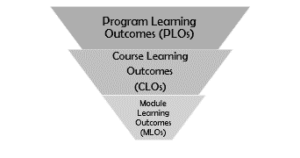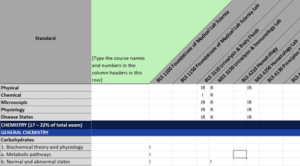Volume 37 Number 2 | April 2023
Starting an Online Medical Laboratory Science Education Program Part Four
Elizabeth A. Gockel-Blessing, PhD, MLS(ASCP)CM
Amanda Reed, MAE, MLS(ASCP)CM


Background
Historically, our MLS program allowed each course instructor almost limitless academic freedom. Course instructors were encouraged to use the American Society for Clinical Pathology (ASCP) Board of Certification (BOC) MLS Examination Content Outline, ASCLS Entry Level Curriculum, and input from our advisory board when developing our courses and course outcomes. As long as our students were consistently successful in each area of the certification exam, course outcomes remained at the discretion of the course instructor. A failure to meet consistency was defined by the program as a cohort of students failing to earn a passing score in a content area for three consecutive years. We were fortunate that based on our exam scores, we had not needed to perform a full curriculum review for quite some time.
From the outset, it was understood by all stakeholders that the online/hybrid MLS program is a new delivery method of the same current in-seat MLS program. It is, therefore one program. As such, the same program learning outcomes (PLOs) in the in-seat version apply to the online/hybrid MLS program. We conducted a thorough curriculum mapping process at each level, represented here in Figure 1.
Figure 1. Curriculum Mapping Levels
Mapping/Bloom’s Taxonomy
The curriculum review process began by performing a curriculum mapping exercise. We used an Excel spreadsheet with tabs for each discipline represented on the ASCP BOC MLS Examination Content Outline. Each tab contained the required components, known in this context as “standards,” and are listed on the spreadsheet on the Y axis and our course offerings on the X axis. Instructors were asked to review their courses and map which courses met each standard and at what level. Using Bloom’s revised taxonomy, the levels were defined as: introduce (I), reinforce (R), and master (M). The screenshot below is an example of the spreadsheet used to conduct this mapping exercise (Figure 2.).
Figure 2. Example of Mapping MLS Curriculum to the ASCP BOC Exam Content Outline
Once each course was mapped against the standards, the resulting curriculum map was reviewed for gaps as well as redundancies. The map was also reviewed to ensure that content was delivered at appropriate levels throughout the curriculum. For example, it was noted that we lacked an “introduction” of blood group content prior to the third semester immunohematology course. A recommendation for improvement was to add this to the blood banking section in the BLS 1000 Foundations of Medical Laboratory Science course taken first semester freshmen year.
Objectives versus Outcomes
With the popular trend of transitioning from objectives to outcomes on the rise, this was a perfect time to review our learning statements and transition them from behavioral objectives to learning outcomes. This terminology is in alignment with the academic program assessment process (see program assessment section later in this article) at the university. The main hurtle was determining the difference between the two terms primarily at the course level. Box 1 provides a simple definition for each term.
Box 1. Behavioral Objectives versus Learning Outcomes
Behavioral Objectives
Measurable statements written in the form of tasks.
Example: State the four (4) blood types.
Learning Outcomes
Measurable statement that demonstrates expected behavior (often in the form of a skill or capability) as the result of completing an activity/course.
Example: Interpret laboratory test results to determine the correct blood type.
Course Outcomes Review
Armed with the information gleaned from the curriculum mapping exercise and firm definition of objectives versus outcomes, we revised our course learning outcomes (CLOs) to ensure that all areas of the ASCP BOC Exam Content Outline were addressed and that the statements were outcomes and not objectives. In addition, we ensured that courses, especially the laboratory courses, met the National Accrediting Agency for Clinical Laboratory Sciences (NAACLS) Standard VIII.A.2 (see Box 2) requirements, which, while they were taught in the previous curriculum, were not clearly outlined. We consulted with each in-seat faculty member in the design and final approval of the CLOs in their assigned courses. Our new CLOs used consistent language that better reflected the language used in the NAACLS Standards across all courses. In addition, we ensured that the new CLOs were a mixture of Bloom’s revised taxonomy levels. Each new CLO was keyed back to its corresponding PLO(s).
Box 2. NAACLS Standard VIII.A.2.
STANDARD VIII. A. for Accredited Programs: Curriculum Requirements-Instructional Areas
2. Were prerequisites identified appropriate and met by current and past students as applicable?
Once the CLOs were finalized, assigned faculty members adjusted their current CLOs to reflect the new ones. These same CLOs formed the foundation upon which the online/hybrid courses were built. Identified individuals, called subject matter experts (SMEs), were responsible for all components of their assigned course(s). The components pertinent to this discussion are listed in Box 3.
Box 3. Pertinent Course Components Developed by SMEs in Addition to CLOs
- Course content organized in modules.
- Module learning outcomes (MLOs) keyed back to the CLOs.
- Module activities, including quiz and exam questions, discussion questions, and case studies, keyed back to the MLO(s).
This exercise confirmed that appropriate mapping was done and that it represents a mix of Bloom’s revised taxonomy levels. Gaps and redundancies were identified if present so that the next steps to remedy them could take place.
Maintaining Consistency Between In-Seat and Hybrid/Online Programs
The current in-seat instructors in the program were given first dibs as to whether they were willing/able to create the online version of their courses. Only select faculty members were in a position to assume this additional role because of workload constraints and other obligations. For the courses that still needed to be built, we hired adjunct faculty members who are experts in their fields (SMEs).
An SME is the course coordinator. In other words, this person not only developed the course, but was given the first right of refusal to teach the course. In some cases, additional adjunct faculty members were hired to teach the course in instances where the SME was unable to take on the role. The SME was the one who was responsible for developing an instructors manual to accompany the hybrid/online course and continues to serve as the point person for all others who may be teaching the course to answer questions and gather feedback for consideration when annual course updates are done. The SME and the in-seat assigned instructor (if they are not the same person) consult with each other at least once a year to review suggested edits and make necessary updates to the course. Some course content must be the same in both versions of the course (see examples in Box 4).
Box 4. Examples of Changes that Must be the Same in the In-Seat and Hybrid/Online Versions of the Same Course.
- Change in course description.
- Change in course learning outcome (CLO).
It is important to point out that SMEs have autonomy as to the textbook chosen for each hybrid/online course but are encouraged to use that which is already in place in the in-seat course. Likewise, SMEs can determine how the course description and CLOs will be met.
Course- and Program-Level Assessment
Assessment documents and processes of the MLS program were reviewed to ensure that both delivery methods are in alignment with each other. The in-seat version of the MLS program already had course-level assessments in place in the form of “artifacts” that include quizzes, exams, activities, discussion questions, and case studies. The hybrid/online version now has its own “artifacts” in place. These assessments at the course-level are primarily used for grading purposes.
The MLS program has an established program-level assessment plan and assessment rubrics. Each year the MLS program is required, on a rotating basis, to examine and assess one (1) or two (2) of its PLOs. Each PLO is mapped to the course(s) from which the student artifacts are assessed. Moving forward, the artifacts from both versions of the program will be used in the program-level assessment process. It is important to note that the program-level assessment process is separate from grading. Rather than grades, the appropriate artifacts are compared with the corresponding assessment rubric that is based on rankings rather than numbers.
Final Thoughts
When we started the curriculum review, the question of “do we (really) have to?” was in the forefront of our minds. It seemed like it was going to be a huge “busy work” project. On the contrary, this exercise turned out to be one of the most informative processes we could have done for the MLS program. We were able to dig deep into the content of each course, identify gaps and redundancies, and develop CLOs that aligned with those at the program level. The evaluation of the taxonomy levels associated with learning outcomes allowed us to ensure that we are developing, teaching, and evaluating our courses at the appropriate levels. The addition of the hybrid/online courses of the MLS program into the program-level assessment process has been a smooth process. This strengthened our ability to obtain valuable data that will be helpful in determining strengths, weaknesses, and future directions of the program. Mission accomplished!
Elizabeth A. Gockel-Blessing is Associate Professor, Medical Laboratory Science, Associate Dean for Student and Academic Affairs at Doisy College of Health Sciences at St. Louis University in St. Louis, Missouri.
Amanda Reed is Assistant Professor/MLS Program Director at St. Louis University in St. Louis, Missouri.
Read additional articles in this series:
- Considering Starting an Online Medical Laboratory Science Education Program? Part One
- Starting an Online MLS Education Program: IT Infrastructure
- Starting an Online MLS Education Program: IT Infrastructure Part 2
Photo credit: Bernd Klutsch on Unsplash

